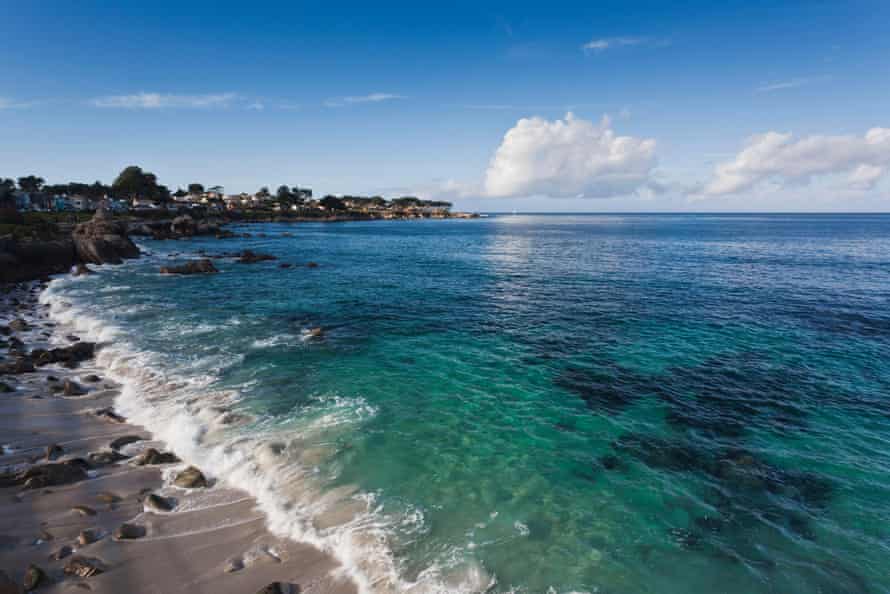The climate crisis is pushing great white sharks into new waters where they are causing populations of endangered wildlife to plunge, research has shown.
Heating of the oceans, which reached a record level in 2020, has led young great white sharks to move 600km (373 miles) northwards off the coast of California since 2014, into waters that were previously too cold. Over that time there was a dramatic rise in sea otters killed by white sharks, with the number in Monterey Bay dropping by 86%.
The overall range suitable for the sharks in the region has shrunk as more areas have become too hot, forcing predator and prey closer together. The shark is the top predator, so its shift is upsetting ecosystems with populations of fish such as salmon also falling. There is concern over the potential for new encounters between sharks and people as well, although the rate of shark attacks has fallen steeply in recent decades.
Scientists hope the disruption to the habitat of a high-profile shark will highlight how global heating is pushing marine animals towards the poles and scrambling the species present in oceans’ ecosystems, with unpredictable and damaging consequences.
“White sharks aren’t just another species – they’re an apex predator and all eyes are on them in the ocean,” said Kyle Van Houtan, of the Monterey Bay Aquarium in California. The shifting of species’ ranges is a global phenomenon, he said. “What we’ve detected here is just a harbinger of much broader patterns.”
“The sharks are not the problem – climate change is the problem,” he said. “The sharks are telling us that the ocean is changing and it’s now time for us to do something about it.”
Prof Malin Pinsky, of Rutgers University, US, and not part of the research team, said: “This is a particularly attention-grabbing example of the mass movement of marine life that’s happening off our coasts right now, involving everything from mangroves to cod. Climate change is scrambling our ocean ecosystems and sometimes it produces surprises with a whole lot of teeth.”
The new research, published in the journal Scientific Reports, analysed the location of great white sharks and the temperature of the ocean using millions of measurements, from tags placed on the sharks to sightings reported by amateurs wildlife watchers.

“We’re able to document a dramatic rise in juvenile white sharks in Monterey Bay that started with a marine heatwave in 2014,” said Van Houtan. Juvenile great white sharks are those under 2.5 metres (8.2ft) in length. Unlike full-grown adults, the juveniles are too small to maintain their body temperature in the normally cold waters of Monterey Bay.
The marine heatwave in the north Pacific lasted from 2014 to 2016. It was called “the blob” and harmed other marine animals, including causing the death of a million sea birds. “Fascinatingly, after that heatwave stopped, it’s still been warm, and the white sharks haven’t left – they’re still here,” said Van Houtan.
The scientists showed that the cold limit for the young sharks moved northwards by an average of 600km between 2014 and 2020. “That’s an incredible distance in just a few years,” he said.
Young great white sharks eat fish before moving on to seals and sea lions as adults. The young white sharks are thought to kill the sea otters as they learn to hunt mammals. “Sea otters are a threatened species and very important for the California coast as ecosystem engineers, both in kelp forests and seagrass meadows,” said Van Houtan.
The scientists found that the area of ocean off California with temperatures suitable for young white sharks – 15C to 22C – has shrunk by about 5%. “It doesn’t seem big in the overall scheme of things but predators and prey are now compressed into a smaller place, where prey have fewer places to hide. So you’re seeing a really rapid decline in fish, including salmon,” he said.
Ocean ecosystems are already being damaged by overfishing, pollution and noise. “They need all of their component parts to survive and thrive and throwing extra factors in the equation, like warming and juvenile white sharks, is just exacerbating that plight,” Van Houtan said.
One particularly warm part of Monterey Bay attracts both people and the young sharks. “It’s definitely become an issue locally, and there’s been a concern for public safety at beaches,” he said. “Even if they’re just juveniles, six or 7ft long and supposedly eating fish, it definitely arouses your awareness.” Recent research has shown that the rate of shark attacks in California has fallen by 91% since 1950 thanks to people having better information on avoiding encounters.
Prof Pinsky said: “This research is also a great example of the power of citizen scientists. Without people recording what they saw with apps like iNaturalist, this massive expansion of white shark juveniles might have gone unnoticed.”